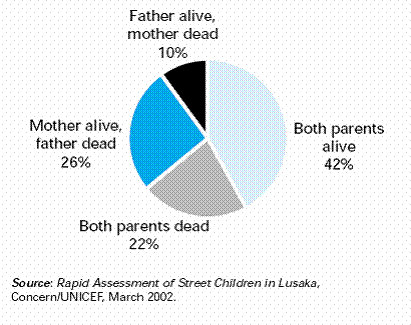
When orphans take care of themselves
“The increasing pressure on families, economic crisis, the shortage of extended families (especially in urban settings), and the fear arising from HIV infection are factors that play a large role in working against keeping these children within the family circle Centre International pour l'Enfance, 1991 “ Pilon and Vignikin, 1996. These factors also favour the appearance of child-headed households, and increase the number of homeless children living on the street.
Orphan-headed households
HIV coupled with poverty is the main factor leading to the appearance of child-headed households. In Zimbabwe Foster, Makufa et al., 1997 and Kenya Nyambedha, Wandibba et al., 2001, it was observed that the main reason for refusal to take in orphans was poverty, and that this poverty was responsible for the emergence of orphan-headed households.
Stigmatisation surrounding HIV can also explain this phenomenon. Some family members may fear taking in a child whose parents have died of AIDS because they suspect that the orphans are HIV-positive and hence fear for themselves and their own children. Even if they do take them in, the orphans are often isolated within the family Nyambedha, Wandibba et al., 2001.
A study carried out in the north of the state of KwaZulu Natal in South Africa revealed that the death of one or several adults in households increased the risk of dissolution of families fourfold Hosegood, McGrath et al., 2004.
Studies carried out in Kenya and Uganda highlight the close linkage between the rising emergence of child-headed households and the distancing and break-up of extended families due to high levels of migration as well as the orphans’ refusal to be placed in a household far from their own homes and separated from their siblings Nyambedha, Wandibba et al., 2001, Mukiza-Gapere and Ntozi, 1995.
Moreover, a study carried out in Zimbabwe confirms this scenario. Children prefer to stay together with their brothers and sisters in their original residence rather than be separated from each other and change households and schools and leave their friends, their homes, and their neighbours even if they must prematurely assume adult responsibilities Foster, Makufa et al., 1997.
Finally, sometimes family members do not recognise a child as legitimate, for example, in the case when a woman has had children outside of marriage or if the dowry is unpaid. This could justify the family’s refusal to care for children after their mother’s death Foster, Drew et al., 1995. Most of these children are double orphans. A study conducted in Zimbabwe observed that most of these orphan-headed households receive regular visits as well as support from family members Foster, Makufa et al., 1997. However, the opposite was true in Namibia where Monica Ruiz pointed to the lack of visits and family support received by these child-headed households Ruiz-Casares, 2005.
This phenomenon observed since the early 90s was confirmed by studies carried out in Uganda by Topouzis Topouzis, 1994, Konde-Lule Konde-Lule, Wawer et al., 1995 and Ntozi Ntozi and Zirimenya, 1999; in Zimbabwe by Foster Foster, Makufa et al., 1997; and in Kenya by Nyambedha et al. Nyambedha, Wandibba et al., 2001. Foster et al. estimated that the proportion of households headed by children under 18 years is less than 1% in most sub-Saharan African countries and has described it as a phenomenon that more frequently concerns older brothers and sisters who are generally 18 years old, who were accustomed to caring for their younger siblings during their parents’ illness, and became head of the family when they died Foster, Makufa et al., 1997, Foster, 1997. A recent study conducted in Southern Africa (Zimbabwe, South Africa, Namibia) tended to show that the percentage may be higher, and that a non-negligible proportion of households are headed by a child between 6 and 14 years old (Human Science Research Council, communication from the 3rd African Conference for Research on Social Aspects of HIV/AIDS, Dakar, 2005).
Obviously, these child-headed households have specific needs, particularly a great need for economic but also psychological support. The study conducted in Namibia showed the high incidence of suicidal feelings among children living in such households Ruiz-Casares, 2005.
Street children
The factors enumerated above have also driven numerous AIDS orphans into the streets, left to their own devices. Whether from exclusion or abandonment, this phenomenon reflects the families’ inability to care for the rising number of orphans and above all, the lack of other alternatives Preble, 1990. This phenomenon rests on current economic conditions and the precarious situations faced by households that develop in African cities. Since the appearance of HIV/AIDS the number of street children has grown considerably. To date, there is no reliable estimation of the number or percentage of orphaned children due to AIDS who live on the streets. However, it is easily assumed that the number of street children is rising in many sub-Saharan African cities most probably due to the growing number of AIDS orphans UNICEF, UNAIDS et al., 2004. In Lusaka, Zambia, the majority of street children are orphans Republic of Zambia and Organisation Internationale du Travail, 1999 as indicated in Figure 6.
In conclusion, among the children living on the streets of Lusaka, 10% are maternal orphans, 26% paternal orphans, 22% are double orphans, and 42% have two living parents UNICEF, 2002 (Figure 6). A study carried out in Congo-Brazzaville confirms these results, affirming that close to half the street children are orphans Nkouika-Dinghani-Nkita and G., 2000.
Figure 6 : Most children living on the street in Lusaka, Zambia, are orphans, 2001.

^ Top
| Acknowledgments |